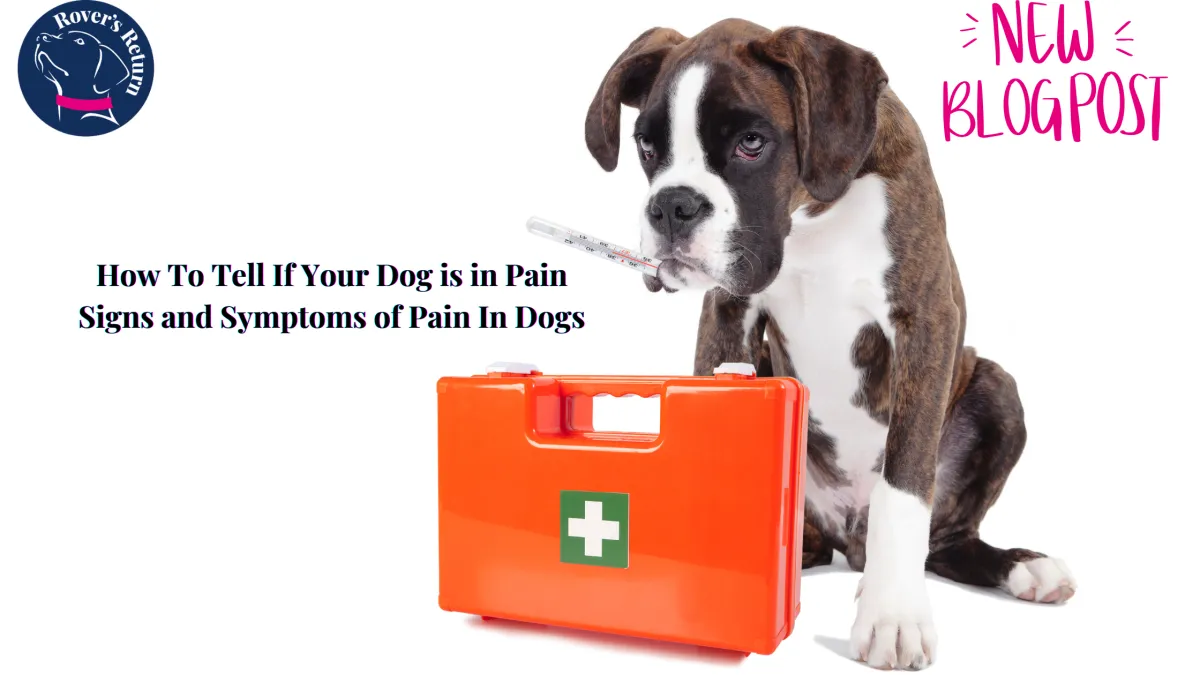Book a FREE 1:1 Assessment Call By Clicking HERE
Specialising In Dog Reactive Behviour
Accredited by APDT, ABTC and UK DOG Behaviour and Training Charter
Qualified and Experienced
Force Free Trainer and Behaviourist
Dog Training Leicestershire Educational Blogs

How To Tell If Your Dog Is In Pain

How To Tell If Your Dog is in Pain
Signs and Symptoms of Pain In Dogs
Dogs are masters at hiding their pain, but there are some key signs to watch for. If you notice any of these changes in your dog's behaviour or physical appearance, it's important to consult your veterinarian.
Did you know that 80% of behaviour cases are pain-related? 35% of dogs suffer from arthritis and 50% are not diagnosed until they are 8 years old!
How do you know your dog is suffering?
Look out for Behavioural Changes And Consult A Vet
The list is not exhaustive, but these are some examples of what can indicate that you dog is sick or in pain.
Lethargy: Less energy, reluctance to play or go for walks.
Aggression: Snapping, growling, or biting, especially when touched in a certain area. This could develop over time or be a sudden onset.
Changes in appetite: Not eating or drinking as much as usual.
Changes in sleep patterns: Restlessness or difficulty sleeping.
Vocalisation: Whining, whimpering, or crying.
How Do You Know A Dog is in Pain?
Physical Changes
Limping or stiffness: Difficulty walking or getting up. This could be constant or happen occasionally but often, for instance after a walk only.
Has their movement changed? Are they compensating, has their movement changed?
Coat patterns, shedding, colour and different patterns in their coats.
Posture changes: Hunched back, avoiding certain positions.
Changes in grooming: Excessive licking or chewing in a specific area.
Changes in breathing: Rapid or shallow breathing.
Changes in bowel movements: Constipation or diarrhoea, this could be constant or regular bouts. Monitor mucous or blood in stools
Limited movement: are they moving less or staying in their bed more?
Or maybe they can't settle in bed and get up and move around often
How Do Dogs Act When They Are In Pain?
Subtle Signs
Changes in facial expression: Ears pinned back, narrowed eyes, or a tense face.
Changes in body language: Tail tucked, avoiding eye contact, or a stiff posture.
Changes in vocalisation: Growling or whining when touched or when moving, lying down or when still
Loss of appetite - They may not want their food or take extra time to eat
How Does A Dog Act When They Are in Pain?
Every dog is individual and you should get to know your dog's quirks and ways in which they move. When their behaviour changes you can have a better understanding of what is happening.
Sudden onset aggression which may be out of context could be pain-related and should be ruled out when working with a behaviourist.
Some dogs may cry or whimper when in pain.
Some dogs may seem a bit off, or lie down more than usual. Listen you your dog and give them the care that they deserve.
How to Help A Dog in Pain
If you suspect pain contact your vet who can advise you. If there are sudden behaviour changes, a force-free behaviourist will help support you.
Never ignore your dog's behaviour no matter how subtle. Pain isn’t always easy to see.
What is Silent Pain in Dogs?
Part of an animal's survival instinct is to hide pain so that it is not seen as a weakness. Vets will often miss pain due to this. It is not always obvious even with a thorough examination.

What Can I Give A Dog In Pain?
It can be dangerous to treat pain without vets advice. For instance, paracetamol is toxic to dogs, but they can have piriton for allergies, but the dosage is not the same as humans and the correct amount must be given.
Natural alternatives may be helpful, but be aware of what is toxic.
Rest, Ice, Compression and elevation can be used for muscular injuries,
I have used cold black tea for eye issues, and cleaned wounds with salt water and manuka honey for sore throats and coughs previously with great results.
If you suspect your dog is in pain, it's important to seek veterinary care. Early diagnosis and treatment can help alleviate your dog's discomfort and prevent further complications.
If you are unsure if your dog is in pain contact your vet. It may help to video your dog's movement from different angles and keep a diary of the progression of behaviours.
Conclusion
Before I see a behaviour client I always recommend a vet check up to rule out pain or underlying medical conditions. Almost all of them say that their dog is not in pain, however, animals are masters at disgusting pain.
Being aware of your dog and how they work will give you an idea of what is going on.
Regualar, annual vet check up are essential. If you are not happy with your dog or feel that they are not giving you the advice that you need then see another vet for a 2nd opinion.
Rovers Return Dog Trainining & Behaviour specilaise in reactive behaviour. If you are struggling with your dogs behaviour book you free call here
Highly Qualified Behaviourist
Accredited by APDT, ABTC and UK DOG Behaviour and Training Charter
Accredited Scentwork Instructor
Force Free Trainer and Behaviour
Force Free Trainer and Behaviour
Accredited Scentwork Instructor
Accredited by APDT, ABTC and UK DOG Behaviour and Training Charter
Highly Qualified Behaviourist
Contact Us
Sam: 07725 802995
You can contact us via Live Chat button at the bottom of the screen or the contact box to the right.
You can also book one of our services online using the View Dates buttons under the service you require.
© 2023 by Rovers Return Dog Trainers Academy - Force Free Dog Training Lutterworth, Broughton Astley, Leicestershire, Hinckley, Nuneaton, Stoney Stanton, South Kilworth, Ullesthorpe
Privacy Policy | Terms and Conditions | Terms and Conditions of Services | Sitemap

Facebook
Instagram
X
LinkedIn
Youtube
TikTok